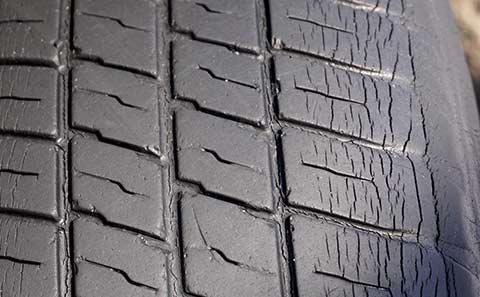Taking a look at a tire speed rating might be confusing at first, but it’s nothing too complicated. It is a single letter that shows you the tire’s maximum speed capability.
Of course, it is not the exact maximum, as tire manufacturers care a lot about your safety. They allow a safety buffer on top of the shown value to minimize the risk.
So, how to find tire speed rating?
Well, the speed rating of tires is easy to find on their sidewall. All the tire speed rating codes are placed right after the tire size’s assigned numerical figures. The speed letters, such as speed index T, speed index V, etc., stand for the specific maximum speed a tire can handle. In this blog, you can find a speed chart that will explain all speed ratings in more detail.
Next to the speed index on tires, there are some other metrics like the tire’s maximum load-carrying capacity. If you want to learn more about these tire classifications, let us walk you through the speed rating systems.
What Do The Numbers And Letters On Tires Mean?
If you are having problems deciphering the numbers and letters on your tire, don’t worry.
Not everyone is familiar with terms like speed rating, load index, speed symbol, and relative load. The simplest part is the tire manufacturer’s name and model. Tire brands are denoted with the biggest letters on the tire’s sidewall near the size designation.
Then comes the tire type, which is mainly about tire size. Let’s take “LT225/70R16” for example.
Here, the “LT” tells you that it falls into the light truck or LT tires category. The number 225 tells you the tire’s width measured from sidewall to sidewall. The next one is the sidewall height or aspect ratio. The number 70 shows you the width related to the sidewall height in percentages. In this case, the tire model’s measured height is 70% of its width. The letter “R” in “LT225/70R16” indicates the tire construction, which is radial in this case.
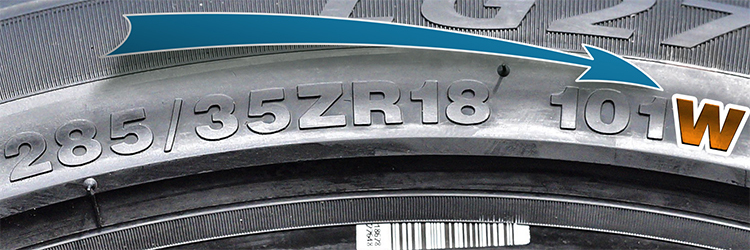
As you can see, the sidewall shows a bit more than just tire size designation with all these numbers and letters.
What Are Speed Ratings on Tires?
Speed rating sets a speed limit for tires under which they remain stable.
Tires with a higher top-speed capability can be controlled more easily at higher speeds. This comes in handy for tires with Y speed ratings (186 mph or 300 km/h). It can endure more of the heat generated at high speeds. A tire with a low-speed rating can become shaky if you step on the gas pedal too enthusiastically.
Denoted speed rating for tires is a result of thorough testing by the manufacturer. However, it is not always precise and we do not recommend going at that exact speed. Other factors such as adverse weather conditions or irregular tread wear may increase risk.
The maximum speed capability for tires is often times over the road speed limits. This is true for models with a Y speed rating and a 186 mph (300 km/h) limit made for sports cars. Tires with a Z speed rating also fall in this category with over 149 mph (240 km/h).
Tire Speed Rating Chart
For those asking what are the different speed ratings for tires, take a look at this chart. It’s a tire speed rating code that represents the maximum speed that the tire can handle under a specific load. Tires with such speed ratings are for ordinary vehicles. This chart starts with the speed rating A and ends with Z, and each letter correlates to a distinct speed.
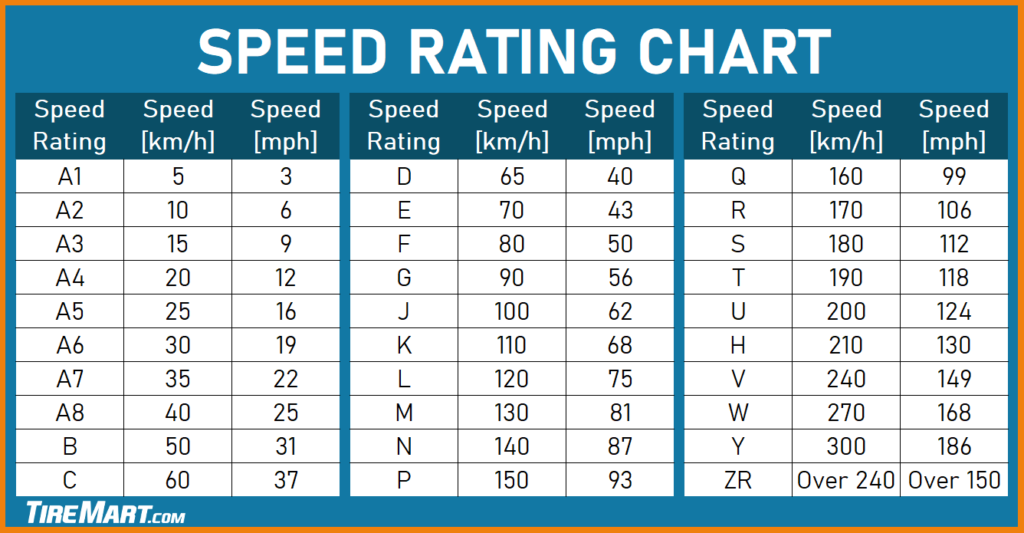
The most common speed ratings chart shows results for passenger vehicles, SUVs, and sports cars. For example, tires with speed rating T have a recommended highest speed of 118 mph, the speed rating H was designed for vehicles with a maximum speed of 130 mph, closely followed by the V speed rating tires, which offer a top speed of 149 mph.
Speed rating W on tires means that they are manufactured for high speed cars. They can achieve a maximum speed of 168 mph, while the Y-rated tires can perform at 186 mph. ZR-rated tires are also designed for high speed vehicles and they represent all tires that offer above 150 mph durability.
Tires with a Z speed rating are used on race tracks, although they are prevalent on ordinary vehicles as well.
What Does 100V Mean on a Tire?
As you can see on the chart above, the speed rating V enables the tire to perform at a maximum speed of 149 mph. On the other hand, the tire’s load index shows us how much weight it can carry without issue.
So, the answer to the question of “What 100V means on the tire?”, is that it represents the load index and speed rating of the tire. The 100-load index means that the tire can handle a maximum load of 1765 pounds, while the V mark shows the tire’s safe max speed performance is up to 149mph.
Why are the load index and speed ratings so important?
If the tire’s load index is too low (you have a vehicle that needs tires with a 121 tire rating, but you put on a 112-rated tire set), the vehicle will struggle during its performance and the tires will wear out faster. If the load index is too high (you need a 111 tire set but you mount on a 121/118 one), then you will significantly increase its fuel consumption.
It’s the same with speed ratings. If the tire’s speed rating is too low for the vehicle’s capability, and you use a T speed-rated tire set on a vehicle that needs a W speed rating, it can’t perform safely. Chances are, the tires will wear faster and probably blow out at higher speeds.
Why are Tire Speed Ratings Important?
In short, the speed rating is there to indicate that if you go faster, the tire becomes unstable. Exceeding the speed limit means more heat is generated. As the air heats up, it also expands, which will eventually cause the tire to pop. On the other hand, you lose the ability to control the tire, as it becomes shakier as you accelerate.
Speed ratings are important exactly for these reasons, as they are there to help you prevent these dangerous situations. As long as you are driving within the indicated speed limit, it should be fine. The tire should behave as promoted by the manufacturer.
What’s the Maximum Speed Capability of Your Tires?
You can find the maximum speed capability for your tire by taking a look at its sidewall. For example, a tire with sidewall information of “P230/75R16 91S” has a speed rating of “S”. Then, you need to look up a tire speed rating chart with common values. According to the information, the tire with an “S” speed rating has a 112 mph or 180 km/h speed limit.
The load index and the speed rating both appear in the tire size on the sidewall. If your vehicle has the right tires installed, then the speed rating matches your car’s capabilities. Choosing a tire with the right speed capability means better control. It enables you to safely maintain road contact within the top speed.

What is a Good Speed Rating for Tires?
There is a speed limit for each and every letter when it comes to speed ratings. The tire’s fixed maximum speed capability can be matched to your vehicle. Tires with different speed ratings should be used on different vehicles. For example, a super sports car can’t use the lowest speed rated tire because it would explode.
For a mid-category passenger vehicle, on the other hand, there is no point in using a Z speed rated one. Before buying new tires, you need to look at the speed symbol denoting the speed limit that matches your car. Take into account the speed your vehicle is capable of and look at tires rated with the respective speed symbol.
There are many vehicles with original equipment tire sets available for the manufacturer. This helps owners find ideal speed rated high performance tires for their vehicles.
If you need further guidance on choosing the tire with the best speed rating, make sure to read our post on the topic!
Speed Tire Rating Comparison
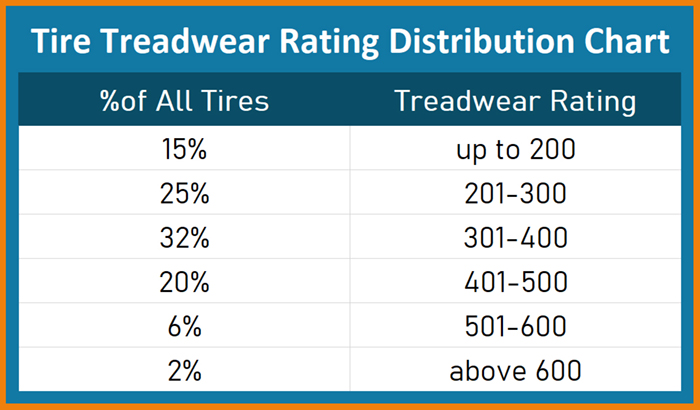
There are lots of different questions about the speed ratings of tires. The most common questions are: “What is the difference between H and V tires?” “Does speed rating on tires matter?” “What’s the difference between 102H and 102V tires?” Comparison is important as it helps us choose the correct tires for our vehicles. So, let us help you with it and make some connections between the speed ratings.
T vs H speed rating tires have various uses. For example, the 114T tire rating is recommended for family sedans and vans because their max speed is up to 118 mph, while H tires are designed for sedans and passenger vehicles. Speed rating H vs T are both good and offer a long service life.
Let’s discuss the H vs V speed rating in more detail. These two speed ratings are most frequently made for performance tires, but which one is better?
The main difference between 91V vs 91H tires is definitely speed. H speed-rated tires have a capability of 130 mph, while the V has a maximum speed of 149 mph.
Additionally, it means that if you want a longer-lasting, cheaper tire, the H speed rating is better However, if you need a really good high speed tire, then the V speed rated tire will be an excellent fit for your vehicle.
It is the same with the Y vs W speed rating debate. The W speed rating on tires means that it can safely perform up to 168 mph, while the Y speed rating can safely reach a speed of 186 mph.
What Other Tire Ratings Are Crucial?
Besides speed ratings, there are other important ratings to consider.
The tire’s load index defines the maximum load or driving pressure in the tire’s service description. The weight tires can carry can greatly vary, just like the weight of each passenger vehicle.
Also, the treadwear rating chart is one of the more crucial tire ratings drivers should know about. However, this tire ratings system shows that not all tire models are equal. The treadwear ratings indicate how long the tire should last, with a higher number presenting a longer life.
To learn about good treadwear ratings, the UTQG rating chart will help you. UTQG ratings are different for versatile tires, because of their tread types. But, a life expectancy tire treadwear rating chart based on the UTQG will be better explained in our blog.
There are also scores when it comes to traction and temperature (UTQG Rating). In service descriptions, traction is rated from AA to C, with the latter being the worst. Temperature handling ability for tires is rated from A to C, where A is best.
There is also the treadwear rate required by the government that shows you the expected tread life. Just to give you an example, tires with a grade of 100 wear much faster than the ones graded 300.
There is also the load range, which should not be confused with the load index. It is also called “ply rating”, which refers to the overall sturdiness of the tire’s structure based on its cord and rubber layers.
Load Rating
The load range is one of the oldest measurements, which presents the tire’s “ply rating”. In other words, the load range indicates the construct of the tire, which is made out of rubber and cord layers. More plies enable the tire to have a larger load-carrying capacity.
Why is it so important? – If you overload your tire, it can cause damage, make it wear out faster, and it can also lead to blowouts.
The load rating appears next to the tire’s speed rating in the service description. It is one of the most important ratings that appear in the size of the tire’s sidewall. Tires have a load index that ranges from 0 to 150. Once you see the number, you can look it up in a tire load index chart and see what it translates to.
Each value has a specific load LBS assigned to it that determines the tire’s load-carrying capacity. Of course, the load index in the service description only shows you the value for a single tire. In order to evaluate the load-handling ability of 4 tires, you just need to multiply it by 4. This can give you a good idea of whether the tires are strong enough for your vehicle.
The tire load rating on tires tells you how tough the tire is. For example: the E load range has a 10-ply construction, which means that it can easily handle loads with a max air pressure of 80 psi.
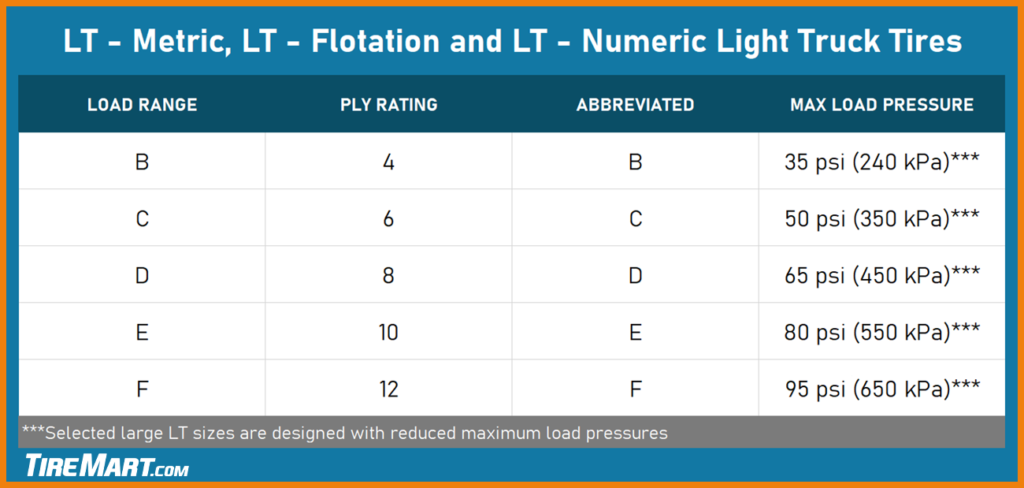
Read more about tire load ranges and ply ratings in our article on the topic!
Passenger Cars Vs. Light Trucks
There are a lot of differences between passenger vehicles and light trucks, but the main one is the strength of their internal structure and cords. This strong structure on light trucks enables the tire to easily handle larger loads. Also, the special rubber compound on light trucks can prevent heat accumulation created by larger loads.
These tires are also distinct. The tread pattern on light trucks is deeper and more aggressive. Therefore, they will generate more noise on highways compared to passenger ones.
A passenger vehicle can use SL (Standard Load) and XL (Extra Load) models. These tires can’t stand big loads and driving pressure. But, if you have a vehicle that you typically drive at high speeds, then you need an XL tire set to handle all the stress and driving pressure.
SL tires are mostly marked with an H or V speed rating, while XL tires often have a W speed rating on them. The important thing to know about high performance cars is that they need high performance tires. This means that they come in handy at speeds between 149 mph and 186 mph. It prevents the tire from heating up too much and ensures reliable handling.
Light truck tires are marked with the letters LT, which means that they are designed for higher durability than passenger tires. Although they are not suitable for driving at high speeds, they are ideal for towing heavy loads.
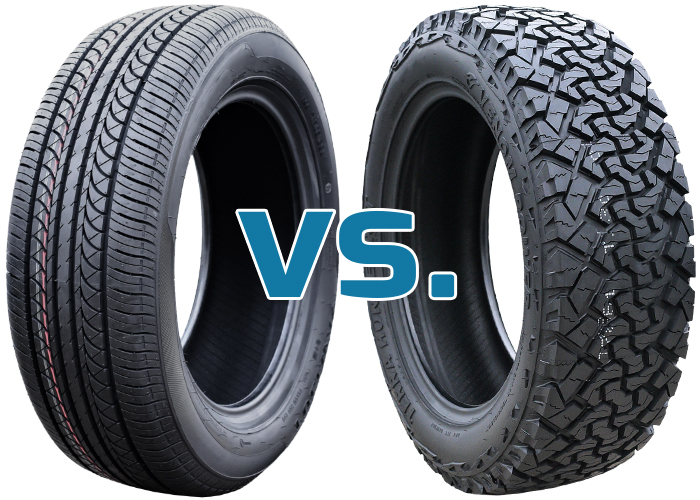
Frequently Asked Questions
What Does ZR Mean on a Tire?
ZR tire rating presents the tire’s speed rating, which means that the tire is designed for high speed capability. ZR tires are a better choice for performance vehicles that may be driven over 149 mph. The ZR speed rating on a tire comes in different types, such as W, Y, H, and V.
Does Speed Rating Matter on Tires?
Yes, the speed rating matters on tires. The tire speed ratings show the tire’s ability to safely perform at specific high speeds. It enables the tires to prevent heat accumulation along the tread area and keeps the model stable at higher speeds.
Can I Put a Higher Speed Rated Tire on My Car?
Well, the answer is a bit complicated. When you buy a new set of tires, you should choose the speed rating that your car’s manufacturer recommends. But, if you want to change it, it is always better to mount higher speed-rated tires than lower ones.
Do Higher Speed Rated Tires Wear Faster?
Yes, high speed-rated tires wear faster. A higher speed rating means a stronger grip on the road surface and a shorter braking distance. Although the tire offers better performance, its tread elements generate more friction. This causes the tread to wear faster, which is one of the costs of such a rating.
What Happens if You Go Faster than Tire Speed Rating?
The speed rating indicates the tire is going to perform well within the designated speed limit. A tire going faster than its speed rating has a high chance of blowing up. It would generate more heat due to the friction with the road surface, causing the air in it to expand and the tire to pop.


